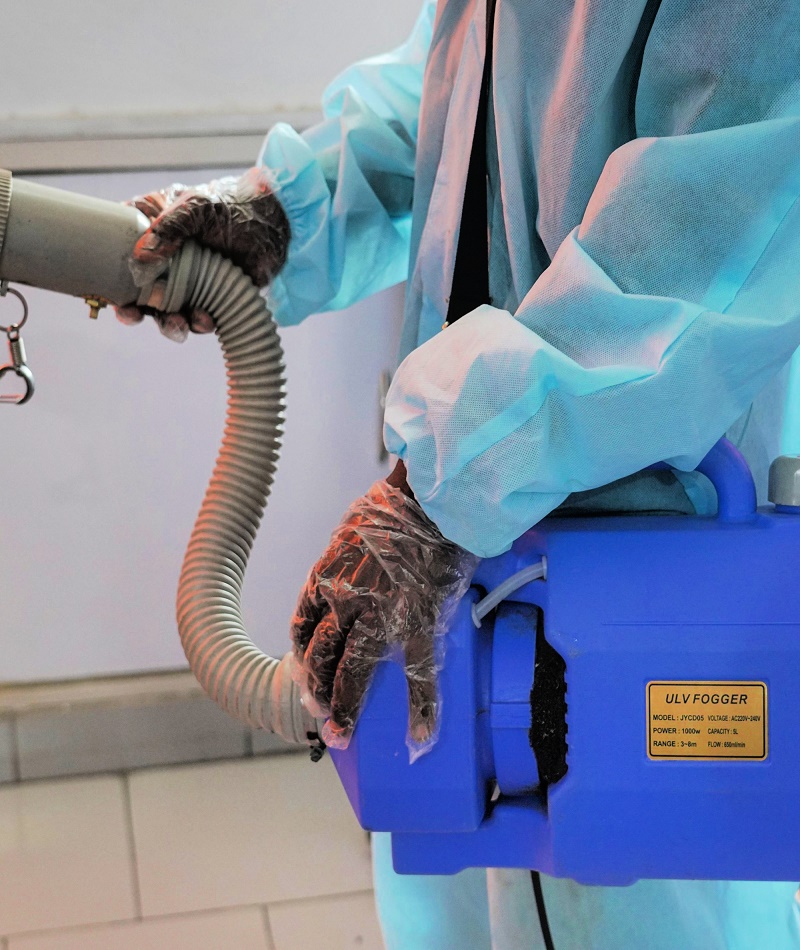Technical
Dosing Systems
We are on hand to offer advice for the best choice of system for the type of soil removal and the cleaning regime required.
All of our products are manufactured to BSEN (British Standard European Norm) and we’ll provide technical safety data sheets which have been written according to regulations. Hygiene scehdules, cleaning procedures and audit sheets are provided for every piece of equipment and area to be cleaned.
This hardware includes the following equipment:
- Tray and Rackwashing Dosing Pumps
- Automatic Dilution Equipment
- Foam and Gel Application Equipment
- Guns, Lances and Hoses
- Fogging Equipment
- Hand-care Product Dispensers
- Hand Pumps
- Factory Wash Down and Fogging Systems

Aerial Disinfection/Fogging
Aerial Disinfection or fogging is used primarily for disinfecting airspace in food production and processing areas. As microorganisms can be carried in the air and transferred to food contact surfaces it may be important, particularly in high care environments, to disinfect the airspace. Fogging should only be conducted after all cleaning and disinfection of food contact surfaces has taken place. It should never be used as an alternative to surface disinfection.
Why Fog?
There may be a need to fog in certain food processes to ensure a reduction in airborne microorganisms that may have come from low risk areas, people and fabric of the building or as aerosols from the cleaning process.
Where Should fogging take place?
Fogging is primarily carried out in high care processing environments, particularly cheese manufacture, salad, sandwich, ready meals, cooked meats and dairies. It is estimated that more than 50% of chilled food manufacturers conduct this method of disinfection in conjunction with the normal cleaning and disinfection routines.
How often should fogging be conducted?
Dependent on the nature of the process and from results of micro sampling and air plate testing, fogging will typically take place on a weekly basis in a high care food processing area. Items such as Blast Chills and Blast Freezers may need to be fogged on a daily basis, dependent on the nature of the product being chilled or frozen, although in some cases where production is required to be running 20 hours per day 6/7 days a week, fogging is not always possible.
How is fogging performed?
Fogging is done by using either a static, purpose built system in an area of a factory with strategically placed nozzles or most commonly by using a mobile unit.
The fogging unit should be left to run its course which takes approximately 30 minutes to complete. No personnel should be in the area that is being fogged as the fog will cause breathing difficulties. It may take up to 1 hour after the fogger has emptied before access to the area is possible. For fogging to be effective a settling period of 45-60 minutes is recommended.
What type of disinfectant is used for fogging?
Usually, a formulated and independently tested QAC based disinfectant, such as Tersan will be used for fogging at 3% solution.
Remember
Fogging should only be used after a thorough cleaning and disinfection procedure has taken place and is not a substitute.
Extensive research has been conducted into the pros and cons of fogging, the following being some of the main points identified:
- Fogging was found to have a good disinfecting effect on upwardly facing horizontal surfaces (up to 6 log reductions after 60 minutes).
- Fogging is not an effective method for disinfection of vertical surfaces, the undersides of equipment or dismantled components because of the lack of chemical coverage on such surfaces.
- Airborne microbiological contamination can be reduced by fogging (2 log reductions after 30 minutes; 3 log reductions after 60 minutes).
- Fogging is most effective with particle sizes in the range 10-20 micron (µm) with air velocity at the nozzle of 100m/s. Larger particle sizes can be used if the air velocity is increased or fans are used to assist the distribution of the droplets.
- Under typical factory conditions, fogging needs to be carried out for a minimum 15-30 minutes to enable the fog to disperse and the chemical action to occur. After fogging an additional period of 45-60 minutes is required to allow the droplets to settle and reduce the risk of operators inhaling the chemical droplets.
- Compressed air driven fogging nozzles are recommended, either plumbed in systems or mobile units.
- Portable electric fogging machines do not operate at sufficient volume flow rate for most applications and are therefore not recommended.
- Where possible, nozzles should not be placed near the floor or be pointed at surfaces within the range of the plume generated by the nozzle.
 01562 755884
01562 755884 info@chemi-kal.co.uk
info@chemi-kal.co.uk

